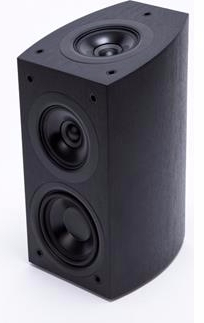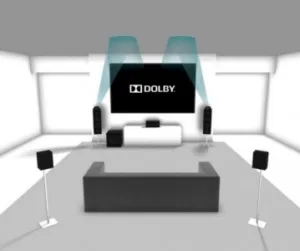It is a retailing insight that dates back to an ancient time, the time of CRT TV sets: “The way to make a TV look better is to connect it to a really good loudspeaker.” Sounds like a recipe for an analog, standard-definition, monophonic home-theater system, doesn’t it? Those old TV salesmen may have been rough-hewn but they weren’t dumb.

A small, highly unscientific survey I performed recently – it was yesterday – indicates there are members of the U.S. display community who are not aware of the advanced audio technology that is or soon will be our version of that “really good loudspeaker.” The technology is “immersive sound,” and it goes considerably beyond the 5.1-channel surround sound with which we are all familiar, even if some of our spouses have drawn the line at having speakers on or against every wall in the living room. (I’m implementing a stealth program right now.)
An immersive or 3D sound system adds one or two layers of height speakers above the ear-level speakers of 5.1 to create a three-dimensional sound field, but they can go further. Like conventional 2-channel stereo, 5.1 surround sound is channel-based. That is, each source is assigned to a channel by the audio engineer, each channel is assigned to a specific speaker in the listening room, and that is what determines the source’s apparent location. Dolby Atmos, the most widely implemented immersive system for consumers, adds an object-based technology that uses metadata to place a sound anywhere in the sonic field independent of speaker location. These sonic objects are placed top of the 5.1 “bed channels,” which still perform their traditional function. Let us note that DTS MDA (Multi-Dimensional Audio) and the soon-to-appear DTS-X also use object-based technologies, although Dolby and DTS use different coordinate systems for defining the sound fields.
Speaker set-up for a Dolby Atmos 5.1.2 installation with Atmos-enabled upward-firing height speakers. There is no need to install speakers in the ceiling, although you can if you want to. (Figure: Dolby)
Auro technologies offers a high-end (that is, very expensive) approach that creates the 3D sound field with 11.1 channels in 3 levels: the base ear-level, and elevated level, and a speaker in the ceiling that Auro calls the “voice of god” speaker. I was able to audition an AURO 3D system at CE Week in New York last June. The mandatory sonic demonstration of an airliner approaching from your rear and flying low over your head to land in front of you had some people ducking, but more subtle demonstrations were actually more impressive.
The playback of Bach organ pieces that were recorded in a cathedral convincingly reproduced the sense of soaring space, and the AURO 3D sound track that accompanied an urban street scene produced precise sonic placements of many simultaneous conversations and activities. As is true in life, you could consciously change your focus of attention and listen in to one conversational fragment or another. The sense of place was remarkable.
 The upward speakers in Dolby Atmos do not make life easier for TV makers to integrate!When Dolby, DTS, or Auro equips a cinema for 3D audio, many speakers are used at different levels. The largest of these installations can support 128 simultaneous objects and 64 speaker channels, according to Film Journal International. Dolby, which has the largest presence in cinemas with immersive systems, was first into the consumer space last year. Clearly, most consumers would not be interested in installing a dozen (or even four) ceiling mounted speakers. So, although an Atmos system can be implemented with ceiling speakers, several manufacturers are making upward-facing speakers intended to be placed on top of the left and right front channel speakers and also (optionally) on top of the surround or rear speakers. Dolby says that such add-on speakers can be very effective for ceiling heights from 8 to 12 feet (2.5-3.5m). A couple of manufacturers are also incorporating the upward-facing speakers into otherwise, traditional left-right speakers.
The upward speakers in Dolby Atmos do not make life easier for TV makers to integrate!When Dolby, DTS, or Auro equips a cinema for 3D audio, many speakers are used at different levels. The largest of these installations can support 128 simultaneous objects and 64 speaker channels, according to Film Journal International. Dolby, which has the largest presence in cinemas with immersive systems, was first into the consumer space last year. Clearly, most consumers would not be interested in installing a dozen (or even four) ceiling mounted speakers. So, although an Atmos system can be implemented with ceiling speakers, several manufacturers are making upward-facing speakers intended to be placed on top of the left and right front channel speakers and also (optionally) on top of the surround or rear speakers. Dolby says that such add-on speakers can be very effective for ceiling heights from 8 to 12 feet (2.5-3.5m). A couple of manufacturers are also incorporating the upward-facing speakers into otherwise, traditional left-right speakers.
So, of what does a consumer Atmos system consist? Minimally, you need an A/V receiver that contains an Atmos decoder and supports 7.1 channels, the traditional 5.1 plus two height channels. Dolby designates such a system as 5.1.2, and says such a system can provide an impressive 3D audio effects. But, they say, for maximum drama (such as helicopter flyovers), you need two more ceiling or add-on speakers to go on top of your surround or rear speakers. That is, you need a 9.1 (5.1.4), Atmos-enable receiver.
All of this comes in at substantially less cost than a small OLED-TV. If you already have a 5.1 system, you only need two more speakers and a 7.1-channel (5.1.2) Atmos receiver, which begin at about $500. Receivers are available from the usual suspects, including Onkyo, Denon Marantz, Yamaha, and Pioneer. There are already discontinued models for bargain-hunters (such as yours truly), but newer models are more likely to have DTS-X decoding as well as Dolby Atmos.
These are a very few words on a very large subject, and I can already see that some of my omissions will generate questions. That’s fine. We welcome questions at Display Daily. But there’s one question I know I’d better answer now. Is Atmos media available? Yes. Blu-ray.com list roughly 60 English-language BRDs that are currently available, and Dolby has a list of more than 50 movies that will be (or have been) released in 2015 and 2016, including The Hunger Games: Mockingjay – Part 2, The Martian, Sicario, The Peanuts Movie, and The Sniper. Standard BRD players support the Atmos coding, so there’s no new investment there.
I will see and hear more at the annual meeting of the Audio Engineering Society, which begins in New York tomorrow.
Regular readers of this column know of my deep skepticism concerning 3D television images. But 3D audio is something else entirely. It draws you into the story — and it does make the picture look better. (KW)

